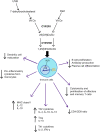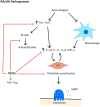Exploring the Evidence for an Immunomodulatory Role of Vitamin D in Juvenile and Adult Rheumatic Disease
- PMID: 33679704
- PMCID: PMC7930375
- DOI: 10.3389/fimmu.2020.616483
Exploring the Evidence for an Immunomodulatory Role of Vitamin D in Juvenile and Adult Rheumatic Disease
Abstract
Vitamin D is synthesized in the skin following exposure to UVB radiation or is directly absorbed from the diet. Following hydroxylation in the liver and kidneys, vitamin D becomes its bioactive form, 1,25(OH)2D, which has been described to have potent immunomodulatory capacity. This review will focus on the effect of vitamin D in modulating the dysregulated immune system of autoimmune rheumatic diseases (ARD) patients across age, in particular in arthritis (rheumatoid arthritis and juvenile idiopathic arthritis), and systemic lupus erythematosus (with adult and juvenile onset). As well as delineating the impact of vitamin D on the innate and adaptive immune functions associated with each disease pathology, this review will also summarize and evaluate studies that link vitamin D status with disease prevalence, and supplementation studies that examine the potential benefits of vitamin D on disease outcomes. Exploring this evidence reveals that better designed randomized controlled studies are required to clarify the impact of vitamin D supplementation on ARD outcomes and general health. Considering the accessibility and affordability of vitamin D as a therapeutic option, there is a major unmet need for evidence-based treatment recommendations for the use of vitamin D in this patient population.
Keywords: autoimmunity; immunomodulatory; juvenile idiopathic arthritis; rheumatoid arthritis; systemic lupus erythematosus; vitamin D.
Copyright © 2021 Zou, Thornton, Chambers, Rosser and Ciurtin.
Conflict of interest statement
The authors declare that the research was conducted in the absence of any commercial or financial relationships that could be construed as a potential conflict of interest.
Figures



Similar articles
-
Vitamin D Supplementation in Patients with Juvenile Idiopathic Arthritis.Nutrients. 2022 Apr 7;14(8):1538. doi: 10.3390/nu14081538. Nutrients. 2022. PMID: 35458099 Free PMC article. Review.
-
Vitamin D and autoimmune rheumatologic disorders.Autoimmun Rev. 2010 May;9(7):507-10. doi: 10.1016/j.autrev.2010.02.011. Epub 2010 Feb 8. Autoimmun Rev. 2010. PMID: 20146942 Review.
-
Can vitamin D be an adjuvant therapy for juvenile rheumatic diseases?Rheumatol Int. 2023 Nov;43(11):1993-2009. doi: 10.1007/s00296-023-05411-5. Epub 2023 Aug 11. Rheumatol Int. 2023. PMID: 37566255 Free PMC article. Review.
-
Vitamin D and autoimmune rheumatic diseases.Rheumatology (Oxford). 2009 Mar;48(3):210-2. doi: 10.1093/rheumatology/ken394. Epub 2008 Oct 17. Rheumatology (Oxford). 2009. PMID: 18930963 No abstract available.
-
Immunomodulatory Effects of Vitamin D in Pregnancy and Beyond.Front Immunol. 2019 Nov 22;10:2739. doi: 10.3389/fimmu.2019.02739. eCollection 2019. Front Immunol. 2019. PMID: 31824513 Free PMC article. Review.
Cited by
-
Tuberculosis and Autoimmunity.Pathophysiology. 2022 Jun 13;29(2):298-318. doi: 10.3390/pathophysiology29020022. Pathophysiology. 2022. PMID: 35736650 Free PMC article. Review.
-
Vitamin D Supplementation in Patients with Juvenile Idiopathic Arthritis.Nutrients. 2022 Apr 7;14(8):1538. doi: 10.3390/nu14081538. Nutrients. 2022. PMID: 35458099 Free PMC article. Review.
-
Prevalence of Vitamin D Deficiency in Patients Treated for Juvenile Idiopathic Arthritis and Potential Role of Methotrexate: A Preliminary Study.Nutrients. 2022 Apr 14;14(8):1645. doi: 10.3390/nu14081645. Nutrients. 2022. PMID: 35458206 Free PMC article.
-
Effect of vitamin D3 on antiphospholipid antibodies in hospitalized patients with moderate to severe COVID-19.Clinics (Sao Paulo). 2024 Aug 27;79:100474. doi: 10.1016/j.clinsp.2024.100474. eCollection 2024. Clinics (Sao Paulo). 2024. PMID: 39208655 Free PMC article. Clinical Trial.
-
Polygenic autoimmune disease risk alleles impacting B cell tolerance act in concert across shared molecular networks in mouse and in humans.Front Immunol. 2022 Aug 24;13:953439. doi: 10.3389/fimmu.2022.953439. eCollection 2022. Front Immunol. 2022. PMID: 36090990 Free PMC article. Review.
References
Publication types
MeSH terms
Substances
Grants and funding
LinkOut - more resources
Full Text Sources
Other Literature Sources
Medical
Research Materials

